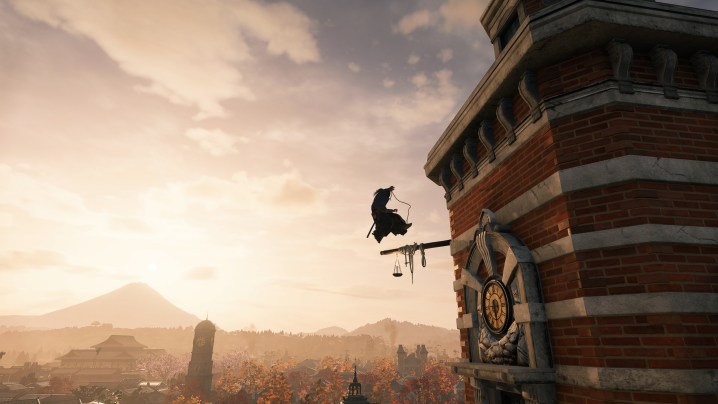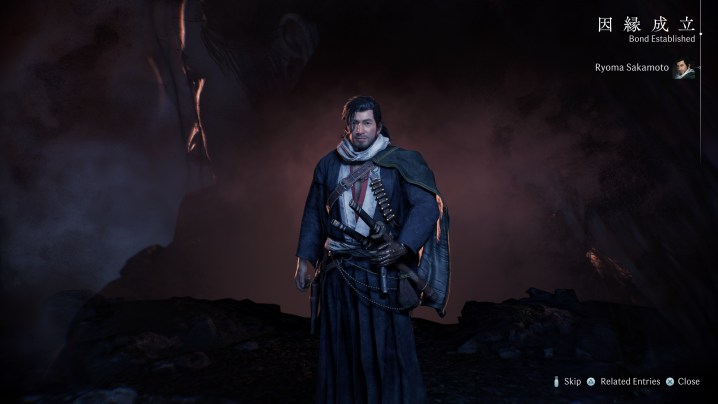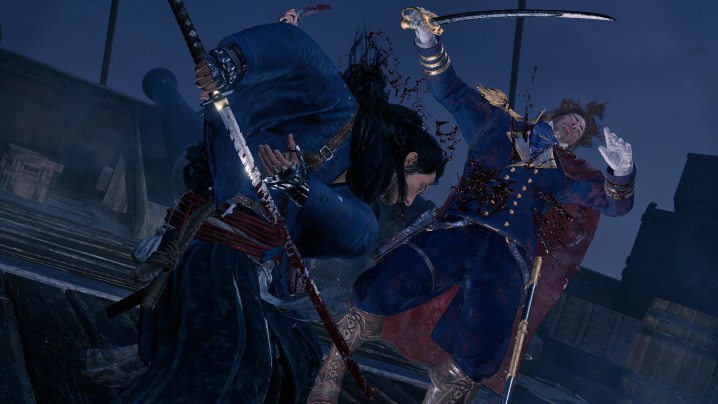
“Rise of the Ronin isn't the best Soulslike out there, but it has one heck of a parry system.”
- Satisfying Soulslike combat
- Thoughtful sidequests
- Strong supporting characters
- Amazing quality of life features
- Branching story lacks impact
- Dual character structure doesn't pay off
At the end of Rise of the Ronin’s prologue, I was given the choice of whether to spare a villain or kill him. I chose the latter. This led to what I thought was an interesting divergence in the game’s story. It wasn’t until after I finished the game that I went back in the timeline to change my choice that I saw how little of an impact it had on the story.
It felt like wasted potential. Not only were some of the plot twists predictable, but I also failed to resonate with the game’s two central characters, as one was a blank slate while the other felt underdeveloped.
Still, I had fun in-between the game’s story moments. Its excellent sidequests helped bring life to its dense open world, making for some fantastic moments for its side characters. Rise of the Ronin also has one of the best parrying systems I’ve experienced in a long time, making the Soulslike gameplay feel challenging, yet fair compared to its contemporaries.
Playing both sides
Rise of the Ronin is set in 1800s Japan during the end of the Edo period, when foreign nations are pressuring Japan to open up its borders to international trade. It follows two samurai who are part of the Veiled Edge clan, but become separated. You can choose between the male and female samurai, and it’s up to you to find your counterpart and navigate the tense politics of the time in Japan.
This illusion of choice dampened any sort of agency I felt.
Pro-shogunate forces want to integrate with Western powers, while the anti-shogunate factions want to keep Japan secluded. The tension between them blurs the lines on who are considered the heroes and villains, creating effective storytelling. Your allegiances play a role throughout the game, changing what kinds of sidequests and gear you have access to, as well as the bosses you fight. Thankfully, after completing the story once, you can access a timeline to see the choices you’ve made and you can replay missions to select a different one. This allows you to experience the story from multiple angles and clean up side activities you may have missed the first time around.
Unfortunately, the flowchart indicates that while you can dictate certain characters’ fates, the story’s conclusion more or less stays the same. This illusion of choice dampened any sort of agency I felt throughout the game. Another peculiar design choice is that the story is told through the perspective of a custom avatar character. While that works for narratively thin games like Elden Ring or Dark Souls, it doesn’t work nearly as well for Rise of the Ronin.

The game would have benefitted from having a more well-rounded and established central character, like Jin from Ghost of Tsushima. Experiencing one of the most politically tumultuous historical events in Japan through the eyes of a protagonist with the personality of a wet paper bag isn’t really engaging.
Bonds in Japan
What adds color to the game’s story are the sidequests you’ll encounter, which is where Team Ninja gets to flex its RPG muscles. Throughout the game, you’ll meet many different characters and form bonds with them, similar to that of Persona 5’s confidant system. There are plenty of incentives to go on these quests, such as earning new equipment, as well as increasing their stats so they can better serve you on co-op missions.
Rise of the Ronin nails its quality of life features.
They’re fantastic for worldbuilding too, and are similar in tone to the side stories in Like a Dragon Ishin!, which is Ryu Ga Gotoku’s take on the same time period. While the sidequests aren’t nearly as goofy or ridiculous as the ones featured in the Like a Dragon series, there’s a nice balance of both serious and lighthearted ones. One moment, you could be gathering flowers to help someone ask out a crush, and the next, you could be fetching Western medicine for a fellow samurai with tuberculosis.
Although this is Team Ninja’s first open-world game, the team followed all the right cues in crafting a vibrant land to journey across. While Rise of the Ronin’s map may not be as diversely lush as Final Fantasy VII Rebirth’s open world, I loved traveling through the grasslands and mountains of ancient Japan, stumbling across new towns, and seeing the hustle and bustle of everyday citizens.

Rise of the Ronin also nails its quality of life features. There are plenty of fast travel points littered throughout its open-world maps. My stamina also doesn’t drain while running outside of combat, so if I want to explore, I can do so without worrying about a stamina meter depleting and ruining the pacing. I love that Rise of the Ronin gave me the ability to set a destination on the map and let my horse auto-run to it. I could just sit back and relax while taking in the scenery and not have to open up my map every few seconds to double-check if I’m going in the right direction.
A balanced Soulslike
While Rise of the Ronin takes inspiration from many of Team Ninja’s Previous games, it plays most similarly to Nioh. The movement, gameplay, and level design make Rise of the Ronin feel like a third entry in the franchise in spirit. However, the parrying attack is a central mechanic in Rise of the Ronin rather than having to be learned as a separate skill in Nioh. Out of all of the parrying mechanics I’ve experienced in games like Wo Long: Fallen Dynasty and Sekiro: Shadows Die Twice, Rise of the Ronin’s is my favorite.
More specifically, its parrying system is the most forgiving and fair. Both regular enemies and bosses have substantially more choreographed attacks, making it easier to parry. In many of these kinds of games, opponents usually have one or two attacks that cannot be parried no matter what, and are signaled by some sort of mark.

Those are present here, too. But instead of being completely unparryable, you just have a smaller window to deflect the attack. It’s a fair trade-off that makes the game much more accessible and less frustrating than your average Soulslike game. While some may argue that it cheapens the satisfaction of overcoming a boss, the game offers plenty of difficulty options to tailor the experience.
Pivotal story moments are structured like raids in a Monster Hunter game, where you can bring along two side characters to act as AI-controlled teammates or call upon your friends to join you in multiplayer co-op to take on missions together. Players can join mid-mission, and the process of setting up co-op groups is relatively seamless. This was a great way to mix in some multiplayer components that don’t feel like they’re encroaching on the single-player experience.
Rise of the Ronin is an admirable attempt to blend Team Ninja’s signature RPG elements and Soulslike gameplay into its first open-world adventure. The fantastic suite of quality-of-life features respect my time, and the compelling sidequests keep me immersed in its world. Despite some missteps with its story and central characters, I’m still interested in going back and exploring what different choices I could have made, even if the results are sometimes underwhelming.
Rise of the Ronin was tested on PlayStation 5.



